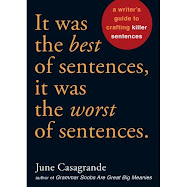For one thing, most other style reference books get updated from time to time. But "The Elements of Style's" status as a "classic" means no one dare touch it (except maybe to add pictures) -- even when its prescriptions become ridiculously out of date.To read the back cover of Strunk and White's "The Elements of Style," you'd think it was God's gift to the English-speaking world -- "excellent," "timeless," "delightful," "… should be the daily companion of anyone who writes for a living and, for that matter, anyone who writes at all."
That's a lot of sunshine blowing around. But something about the beloved nature of this little book has always sat funny with me.
But there was something else that bothered me about this "beloved" little book that I was never able to put my finger on until I scored a copy of the original "Elements of Style" by Cornell professor William Strunk, Jr., long before his student E.B. White landed the job of revising it.
Consider this entry in the original "Elements of Style"
Headings. Leave a blank line, or its equivalent in space, after the title or
heading of a manuscript. On succeeding pages, if using ruled paper, begin on the
first line.
Ruled paper?
Now, I had always known that "The Elements of Style" was born of a college classroom. But it never really occurred to me what a fraud was perpetrated on the reading public when White "revised" the thing. Basically, his task was to take a book written for a small and specific group of students and make it marketable to you and me. Sure, this happened because the original "Elements of Style" had already found an audience outside Strunk's classroom. It sort of caught on like wildfire. But White nonetheless pulled a fast one on us when he tried to make Strunk's student instructions required reading for everyone who might ever hold a pen.
For example, before Strunk's passage above, White inserted:
"If the manuscript is to be submitted for publication …"
Then he nixed that reference to "ruled paper," knowing full well that newspaper editors, resume writers and business-correspondence writers who were the book's new target market don't use ruled paper.
But Strunk never meant "The Elements of Style" to be a book of iron-clad rules for you and me:
"This book … aims to lighten the task of instructor and student by concentrating attention … on a few essentials."Yes, "The Elements of Style" contains some great wisdom, mixed in with some old-fashioned silliness. But unless you're a Cornell student stuck in a time warp, don't consider it an ultimate authority.





1 comment:
June, great stuff here...Especially about
marketing by E.B. White, whose name appears marketably enough appended to the "Elements of Style" which I as a freshman had to buy from the Michigan State U. bookstore, because the prof. said it was definitive.
But wait, here's another layer of marketing: the other day, seeking to confirm the true form of possessive forms in their various contexts I consulted Strunk (and White)...whoa, what do I find but:
The New Improved Elements of Style Illustrated by
Maira Kalman
who, her dust jacket blurb says "...has illustrated twelve children’s books, numerous covers for The New Yorker, fabrics for fashion designers Isaac Mizrahi and Kate Spade, and many other projects.
Wha?
Leafing through I found garish doodles depicting William Strunk as if he were a cartoon interspersed with his clearly stated directions.
If Strunk had found such doodles in one of his student's notebooks in his English class at Cornell
in 1918, he'd surely ask, I feel sure, pointedly, "Why are you wasting your and my time?"
But now I've found the 1918 edition Strunk originally authored and feel as though I can carefully strew possissives where they're needed and not where they're not...
Brian Orr
Post a Comment